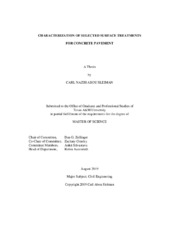| dc.description.abstract | For a concrete pavement, the permeation properties for the surface have a crucial influence on its durability. Current practices assess the resistance of the surface to abrasion and freeze/thaw cycles based primarily on the compression strength of the concrete. A prominent way to enhance the durability of concrete is by use of surface treatments to reduce water and chloride penetration. In other words, surface treatments partake in protecting concrete surfaces from the ingress of deleterious substances such as salt, organic impurities and dust. The objective of this thesis is to investigate the efficiency of organic and inorganic surface treatments regarding abrasion, freeze/thaw damage, water and chloride penetration. ASTM standards were modified to abbreviate the testing and assess the efficiency of different products. Based on the tests performed, organic surface treatments remarkably increased the resistance of concrete subjected to freeze/thaw cycles by reducing the water intake compared to the inorganic ones. Similar results were observed regarding the chloride penetration test leading to an improvement in durability. The abrasion resistance of a concrete surface can be improved using inorganic surface treatments based on lithium and silicon.
A model was proposed to relate the abrasion efficiency as a function of load cycles of a treated surface to represent the longevity of a concrete pavement. Based on the abrasion coefficient and the texture wavelength which is a measurement of the quality of the surface of the pavement, it is shown that the life cycle under abrasion of a concrete pavement can be calibrated. As part of the laboratory testing program, the untreated concrete specimens were used as the control. Results from the abrasion and freeze/thaw testing of treated specimens indicated a lower level of cumulative damage, which confirmed the benefit of using such products relative to the extension of the service life of a concrete pavement surface. The results of modeling indicated an increase of 14% of the ultimate load application to failure for the treated specimens, which indicates an increase in longevity of the pavement. | en |


